#that I think works with Batman's key traits and themes
Explore tagged Tumblr posts
Text
Kind of bummed out that The Batman's successors will likely focus more on "grounded" villains instead of the likes of Pamela Isley, Basil Karlo, Waylon Jones, or Victor Fries (or if they are present, they'll likely have some kind of symbolic association to their powers rather than outright), just because in my opinion, the first movie would have established in the background if sentient plant powers or any kind of abilities were even in the realm of possibility for Gotham.
#It should be said I have an arc for how I think the movies should go#that I think works with Batman's key traits and themes#and I shall happily give it to DC because I don't trust them#but The Batman is very street-level focused#lots of emphasis on the mob/systematic corruption/good intentions paving the road to hell#I think the street level crime shall predominate unfortunately#batman#bruce wayne#the batman 2022#battinson#dc comics
76 notes
·
View notes
Note
Do you ever find yourself slightly resentful of how fanon DC has completely overtaken canon DC? I like fanon most of the time but it is so difficult now to find stories that are based in canon. Batman stories are by far the worst offender.
I'm not 100% sure if you're referring to the fact that a lot of recent stories in the comics are pretty ooc or if you mean fic, but based on the last few days of asks, I'm going to assume you're referring to fandom works specifically. And the answer honestly is yes.
I in general have complicated feelings towards fanon. While certain types of fanon can actually create stories that are more complex - for example most of the Spider-Man fandom has pretty much accepted that Peter is Jewish and has depression and anxiety - or even just make for pretty fun concepts - I just love stalker!Tim okay I don't know what to tell you, or purring!Spider-People!! - the vast majority of fanon is mostly really flat characterization or actively damaging. Going back to Spidey, pretty much every bit of MCU!Spidey fanon is fucking awful. And yeah, a lot of Batfam fanon, especially surrounding Jason - is really fucking awful.
I think it's fine for fanon to exist, but the fact that it so often overwhelms the actual canon stories means that sometimes canon gets actually rewritten in people's minds. Like the people who've been in my inbox recently asking me if pit madness is actually a thing - because if you've had minimal contact with canon, how the fuck are you even supposed to know it isn't? It's so rare to come across a fic that doesn't bring it up, even as a sidenote, and when it doesn't, it's not like it's an active mention that pit madness doesn't exist - it's just there. And it's such a damaging piece of fanon, I know I keep bringing it up but it's because I have to, it's really harmful, especially since it's basically NEVER given a trigger warning. But there's also other annoying fanon - Cass as a perfect angel or Steph being reduced to a waffle fan and Tim to a coffee addict and nothing else and erasing Dick's canonical anger issues entirely, which is maybe my favorite character trait of his (although this one can also be blamed partially on Tom Taylor's terribly ooc writing of the character in the current Nightwing run...).
And the thing is yeah, sometimes we read fic purely for the escaping and the fluff, but I know a lot of us are looking for angst and hurt/comfort and fics that take themes (whether from canon or not) seriously, and it's really frustrating how difficult they are to find. I much prefer a fic that takes Dick's trauma seriously than one that relegates him to supportive older brother only. I much prefer a fic that wrestles with Bruce's inability to love Jason the way Jason wants him to and the physical abuse he's inflicted on his children than one where he's perfect and never done anything wrong. Yeah, I don't mind reading stuff for fun where there's never been anything wrong ever in the batfam. But I'm also low-key upset that my second most kudos'd fic ever is the stupid ooc batfam 5+1 I wrote in an hour. I'd much rather people read hang on which verges on character study and has, you know, themes and stuff. Also parallels, which if you've noticed my tags, are like, my favorite thing.
So yeah, I do dislike the fact that fanon has overwhelming taken over so many fandoms, and especially since batman has become my main fandom over the past few months due to brainrot, I'd love if people took these characters seriously, damnit. But this is what happens when a fandom is so majorly comprised of people who outright admit to have never read a comic in their life.
#dc#batfam#fic#fanon#fandom#fandom meta#spiderman#anti mcu#as usual#marvel#marvel comics#god I really need people to start treating batfam members as complex people especially dick and cass#also if you're unfamiliar with the tag I referenced here it is#parallels are like my favorite thing#gail speaks#ask#anonymous
48 notes
·
View notes
Text
Gotham’s 31 Most Wanted - Number 11
Welcome back to Gotham’s 31 Most Wanted! Each day of January, I’m counting down my Top 31 Favorite Batman Villains of all time! Today’s villain is a real beast. Number 11 is…Killer Croc.

Ohhhh, this guy…Waylon Jones. Dear, dear Waylon Jones. Don’t you and I have some interesting history together? XD So, here’s the thing…a long time ago (well, not THAT long, but a few solid years), I actually made a list of my favorite Batman Villains reaching up to the top 24, on a different site. With this countdown, that Top 24 has changed in several places (nearly every place, in fact), but perhaps no change was greater than the change this guy took. I won’t say where Croc ranked initially, but it was a bit further down…and this was mostly because I didn’t really KNOW Croc all that well. See, I basically knew Croc through…oh, maybe one or two comics where he wasn’t the real focus, and a few select versions in other media. We’ll get to that issue in a little while, but the purpose of me saying this is that, for many years, my perspective of Killer Croc was that he was basically just a thug. A cool-looking thug, mind you, but still a thug: he was just a brute that Batman needed to beat up, and while he could occasionally be scary, he wasn’t all that interesting. Again, that is what I THOUGHT. In the time that spanned between creating that list and working on this countdown, I discovered that the character was actually rising in popularity, and that several people I knew – some of them very close friends of mine, both online and offline – really, REALLY liked Croc as a character. This intrigued me, needless to say, so I started reading more of the comics…and what I found there was a villain who was much, MUCH more than the “Hit ‘Em With a Rock!” dunderhead I’d perceived in some other interpretations. Originally conceived as a gangster with a rare skin condition that gave him a reptilian appearance, Killer Croc, over the years, became essentially a perfected interpretation of what Man-Bat is in many ways. As I said on Man-Bat’s entry in the countdown, the problem with that character is that nearly every story with him feels the same: it’s a story about Kirk Langstrom trying to regain his humanity. Waylon Jones has much more variety in his tales. Croc deals with similar issues, but with a deeper twist: this guy literally can’t help the fact he’s a monster. His body and mind are steadily regressing to an animal state, so as the years pass, he finds it harder and harder to keep hold of his sanity and his humanity, becoming more beastly and monstrous, both inside and out. Killer Croc is a character who can be fierce and intimidating, but usually isn’t the brightest bulb in the box…heck, even in the early days when he actually became so powerful he basically RAN Gotham City (no joke, that was a thing), he was more cunning and ruthless than he was a genius or a mastermind. These traits have carried over into other media, but the tragedy and pathos of the character found in comics have not. We’ve never really seen a version of the character outside of comics who struggles with the constant daily battle of his bestial instincts and his human soul. The Croc in the comics is funny, sad, and at times sort of sweet; nothing like what we’ve gotten in most other versions, which usually capture one or two traits, but somehow always miss the key element. The Croc in the comics EATS PEOPLE ALIVE, but he doesn’t necessarily always feel good about it (keyword being always). He’s another case of where, in more recent years, he’s steadily been turning into more of an anti-hero than a true villain: he can be a monster, some would argue he IS a monster, but he’s a monster with layers and reasons for what he does or does not choose to do. Most versions outside of comics take Croc’s “victim of prejudice” element almost as a lame excuse for him to use to try and justify his actions: in those takes, he looks like a monster, and lo and behold, he really IS a monster, and has no problem with that. In the comics, Croc doesn’t WANT to be a monster, he literally just can’t help it, and when you couple his natural issues with his past, you can understand why he behaves in the brutal and vicious ways he does, but it also makes the good things he does more powerful as a result. So, in short, Croc has the exact same problem as Mr. Freeze from our previous entry, but now in reverse: the comics handle him okay – in fact, more and more recently, he seems to be handled better and better – but other media can’t seem to quite get the hang of him. So, why does he rank higher than Freeze, with this in mind? There are two good reasons. First of all, the comics are where these characters are born and thrive, at least for the most part (I’ll get to an exception to that later in the list), so to me, it’s a bigger sin for a character to not be done well in the comics themselves than in other media. Second of all…sort of tied to that, and this is going to sound kind of weird…I don’t really MIND that Killer Croc isn’t handled as deftly in other media as he is in his home turf. Now, some of you – especially major Croc fans reading this – may be wondering, “Why not? You just went on this big spiel of how other versions do him an injustice!” Well, here’s the thing: while it’s true that most versions don’t really play with Croc’s inner struggle much, if at all, they DO still find ways to make him interesting. In the Arkham games, we see – over the course of the series – the way Croc’s mind and body change as his condition takes him over more and more. In “The Batman,” Croc is more cold-hearted than ever, but he’s also a mysterious and fascinating foe with a strategic side; he’s handled better than BANE, who many would call a better villain and coincidentally has had a rivalry with Jones since kingdom come! I’ll even throw the Animated Series a bone: yeah, it made Croc-o the “Hit ‘Em With a Rock!” guy, and his condition was more often used to trick people rather than gain genuine sympathy from the audience…but to be fair, he WAS a funny and at times intimidating villain, and the chances are good that if I hadn’t met Croc in that show or other versions I’ve mentioned, I never would have known about him at all, and probably never would have bothered to eventually take time to read his comics. I think that’s the real reason why other media DOES continue to use him over and over again. Croc WORKS as a big, nasty thug because, once you take that human element out…that’s exactly what he is. A big, nasty thug! And while we always want something more complex and engaging, is it really so bad to once in a while enjoy Batman fighting a monster? In fact, the mere presence of Batman facing a guy like Killer Croc can play with those themes: the logical and scientific mind of the detective versus the rampaging ferocity of a cold-blooded fiend is another parallel a lot of people, even major Killer Croc fans, don’t seem to latch onto. So…yeah. While on the one hand I feel mad about how other media never captures “The Real Killer Croc,” I can’t act like I don’t ENJOY versions of him from other media. I do! So, on the whole, between both places – the comics and beyond – he just has a better and more consistent track record than Mr. Freeze. Given how many people I know seem to love this guy, I actually feel a little bad for not putting him in the Top 10…but I guess, at the end of the day, I still like the other villains above him more. Speaking of, we have officially reached the Top 10! Tomorrow I’ll be covering my 10th Favorite Batman Villain! HINT: “The Man Who Broke The Bat.”
#gotham's 31 most wanted#january advent calendar#new year's countdown#batman villains#batman#dc#comics#supervillains#best#favorites#killer croc#killer#croc#waylon jones#waylon#jones
8 notes
·
View notes
Text
Robin - the First Miniseries - Issue #3 review - (R.I.P Tom Lyle)
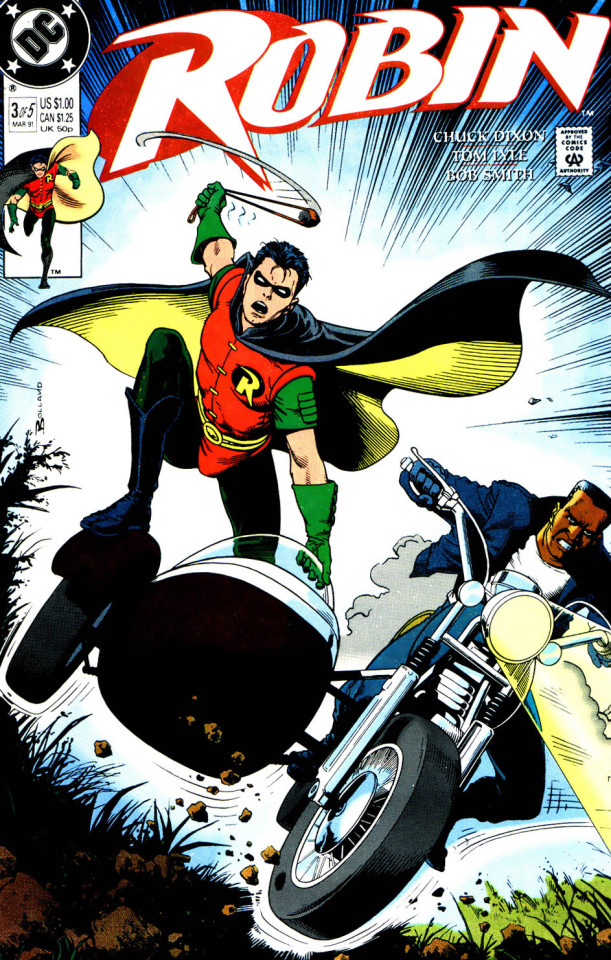
One thing I find kind of endearing about Tim’s narration, is that it reads like a kid that has to recount stuff just for his own sake, because he’s having a hard time believing any of this is happening.
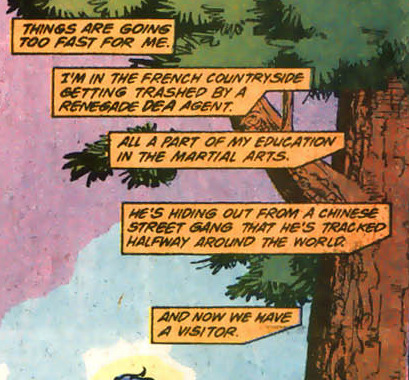
Which matches up with the face he makes.
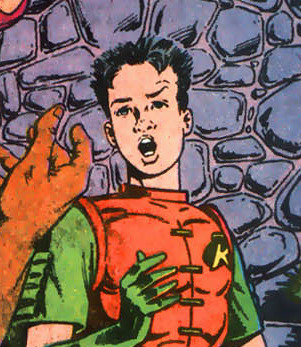
--
Have some more people seemingly finding Timmy adorable.

Although, you sort of have to think that Tim’s too innocent for his own good sometimes, because he’s trusting the women that calls herself “The Most Dangerous Woman in the World” probably because she treats him like a baby.
However she does say she met Batman, but even then, for some one who works with the notably untrusting Batman, Timmy’s a bit too earnest and naive to trust her so fast just because she can’t stop pinching his cheek and treating him like a puppy.
That’s just good character work though. Tim isn’t perfect, a big part of this miniseries is how out of his element and naive Timmy is. So it just fitting in with his character.
(The next scene ruins this though)
Lady Shiva: I diagnose you with baby
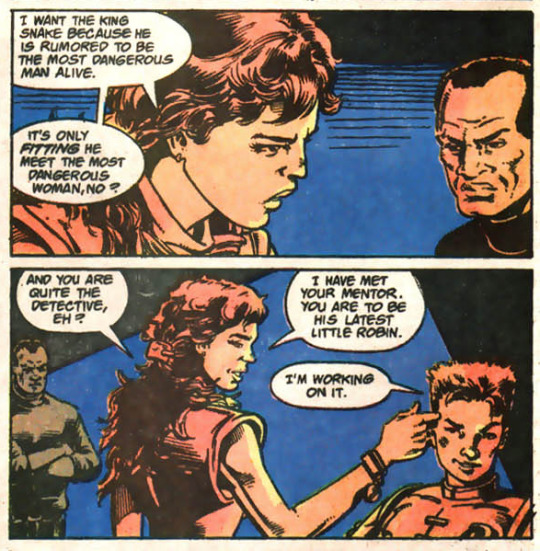
Very early on they set up this bizarre trio’s dynamics pretty fast.


It’s done fast, but very naturally. It’s done through natural character interaction. So it isn’t distracting. It’s well-done. Even if it sort of implies Clyde’s a sexist, but ya know what, character’s aren’t made to be perfect people. They’re made to serve a function in a story. Part of me wishes they’d delve into it more though after they set the stage for something that’s mostly just left at implication. To leave a moral of some kind after such a salty interaction ya know, because it’s taking away the function. I guess Lady Shiva does tell him off for it though. So I suppose that’s the function.
(Which isn’t the last or first time questionable morals from side character’s get left behind, but sadly it gets more blatant and gross. It’s the main flaw of the miniseries. Occasions of awkward writing imply stuff that doesn’t get furthered acknowledged, when it feels like it should be)
So the character dynamic is like this:
Tim is the naive, computer baby, who both of the adults like.
Lady Shiva is the terrifying dangerous woman who knows stuff
Clyde’s the untrusting, rough around the edges, angry one
Lady Shiva and Clyde can’t stand each other, but they’re pretty much here for the baby at this stage. So they’re going to have to try to get along for this little adventure.
Very simple, but this miniseries is 5 issues long, and it’s genuinely all you really need to understand what these characters are going to be like. In general that’s a lot they set up for their dynamics in just one scene. So that’s pretty good actually. These aren’t characters that are gonna last long together, to get just that much for something short lived is good work.
After pretty much failing every fight he’s been a part of, Tim probably seems pretty useless to people, but here’s to remind you, that he’s not.

His strength isn’t his fighting ability. He isn’t Cassandra Cain (who wasn’t created yet. Well, technically, but I mean in the real world perspective). His strength is using his talents at computer and mind to help solve crimes. That’s how he’s useful.
While no genius. He’s clever. That’s his talent.
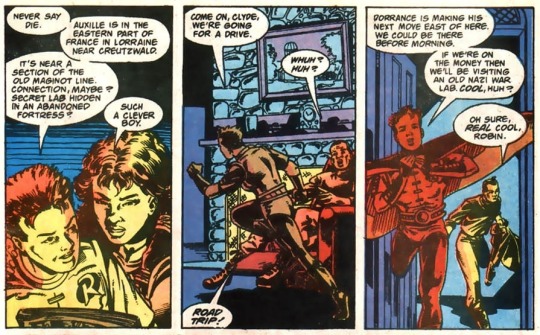
Another cool thing about this issue is that this is were Timmy finally starts getting into the groove of this superhero thing.
He’s still not great at it, but you see him start getting more used to it compared to the first two issues. He’s growing as a hero.
--
The thing about this issue that I don’t like though, is that it starts to delve into trying to give Timmy a case of the “not gays”, because it randomly starts to pretending that Tim’s interactions with women were more than what actually happened.

Like as far as what was actually drawn in written. It looked more like Tim was wanting to show off to his mommy that was giving him tons of affection more than anything else.
Even the writing of this scene kind of says Tim doesn’t care. The way he words himself “I guess”, like he didn’t actually think about it. Which fits in with his character. He doesn’t seem to care about girl’s that much. I expect this reaction from him, but it’s how the comic itself continues to tease Tim with girls in a way that feel unnatural, because he’s not even getting flustered like how a kid would when getting questioned with girls. He’s just like “I suppose so”, like he doesn’t even care. The look on his face is so low-key too.
The writing of the scene even goes to say he actually thought of her as scary, which adds even more disconnect, because he clearly wasn’t scared of her. He was melting into her palm and was enjoying every compliment and cheek pinch he was given.
Maybe it’s just Clyde trying to ruffle his feathers though when it comes to the teasing.
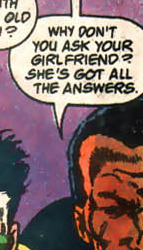
There’s a certain amount of disconnect for me regardless, given how the previous scene played out to this. It’s just strange. Maybe that’s supposed to further Clyde’s character as a sexist maybe? But that doesn’t get fully played out either.
Things don’t add up much in this issue as well as the others that were really good with the character thing besides one scene.
As far as the last scene went, it’s played out like Tim loves Lady Shiva because she treats him like a puppy. There’s nothing to imply he found her attractive, even in this scene despite Clyde acting otherwise, seeing how Tim didn’t even think of her being beautiful (he had to have that pointed out to him), but instead scary, but even then there’s nothing there to imply he finds her scary either in the first scene. He seems too innocent and trusting actually. So it’s just a badly written scene, because it’s not adding up.
--
They continue this weird disconnect even more so into the next scene with Lynx, because Tim even backed away from her when the flirting started.

Because freaking when? He blushed when you showed him affection. He melts when you touch his cheek. That’s what they actually show happening, but what do you mean lovestruck? He saved you cuz you were getting messed with and hurt. He did the same thing with Clyde. He even took Clyde’s clothes off if you wanna force any sort of lovestruck, but that’d be creepy if Tim did that cuz he had a crush, so i’d rather not go that far with it. Just trying to prove a point.

Like look at him. He’s freaking uncomfortable. This doesn’t scream “lovestruck” to me. It’s more disconnect that throws the scene off of tone a lot.

If anything you were lovestruck in him. He’s trying to back away.
The kid just melts in times of affection, that’s what they actually show us, and girl’s are the ones that give him affection. There’s not actually a lot, arguably freaking nothing besides how he acts when he gets affection, that screams lovestruck. Other people say he is more than what Tim himself actually shows.
Regardless of the weird sudden insistence that Tim was in love with this girl more than what’s actually shown. There is some great imagery by Tom Lyle that the scans don’t do justice.
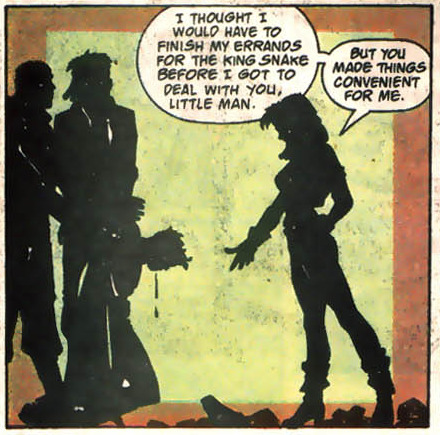
Some nice moments that shows Tim getting more used to the superhero life style too.

But of course there’s more of this ‘Timmy’s weakness for girl’s’ talk that doesn’t add up to how he actually interacts with him.
It’s like a bizarre crude bad version of ‘show don’t tell’, they’re telling us something when they show something else.

Like Clyde, Tim took you to a fancy hotel and rented a farm house for you to stay in as he bought you new clothes. If you were Tim’s age that’d be considered romantic, and Tim might be called a sugar daddy. He’s shown to have more of a crush on you then freaking Lynx at this point, okay, and I don’t even think Tim has a crush on you. You just don’t pinch his cheeks and play with his hair like everyone else.
(And don’t start any gross ships okay. Clyde looks at Timmy more like a son above anything else, and there’s a massive age gap, along with it being genuine pedo-freaking-philia. I’m just saying this whole thing is dumb to me, because besides being incredibly easily susceptible to any form of affection he is not shown to have an attraction to anyone. So it makes this seem contrived. They don’t do anything to show Tim has an actual romantic, sexual, or aesthetic attraction to freaking anyone. He just loves affection)
--
Have some more Timmy getting used to this superhero thing, showing his morals, and actually being pretty bubbly.

He’s adorable.
Although maybe he’s getting too used it, because now he’s got that little kid instinct of going a bit too far and too stupid with it.
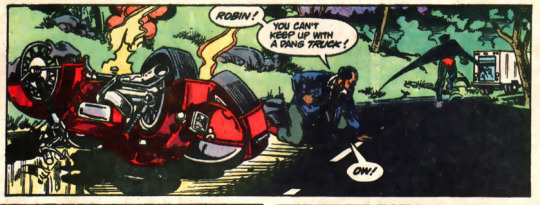
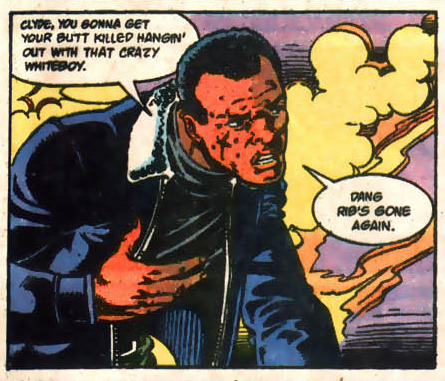
A pretty fair reaction honestly.
--
So there’s some panels of showing off how rich King Snake is, which I instinctively skipped over because he’s so forgettable that I forget I should probably actually pay attention to him.
Basically he’s going to poison the water supply, and unleash a plague into people’s houses.
I can’t wait for him to burn the crops too. I don’t remember what he does, so I have no idea if he will, but I sure hope so.
--
Timmy doing some computer styled detective work, because this is one modern boy. I wish they’d have Tim just solve a crime on his phone in a current comic, because he’s not an Oracle-styled computer user, he’s mostly just a kid that knows how to use the internet.
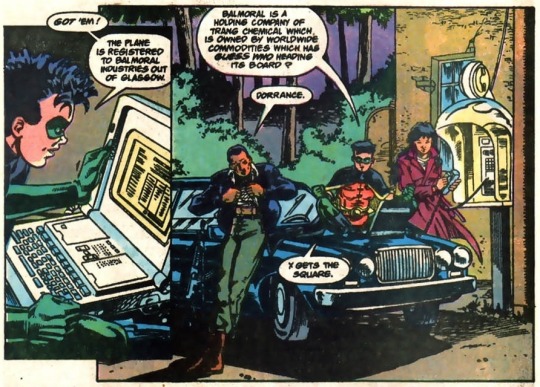
He’s so small. I love him.

Baby Sherlock does his best to use his big brain to put it to good use solving the case.
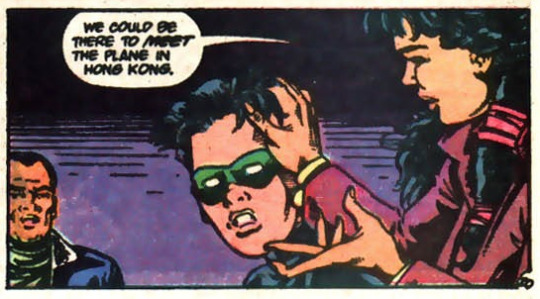
--
Another notable trait of Timmy’s, is that he is perseverant as could be. Like he just went to France to learn more martial arts and some street smarts cuz he gets his butt kicked too easy and he’s naive as could be. Now he’s stopping a terrorist with two people he didn’t even know.

They also delve into a bit of the understated sadness of Tim’s character. How, despite him obviously being a kid, who acts like a kid so far no matter how heroic he tries to be. He doesn’t feel like he as himself should be a kid.
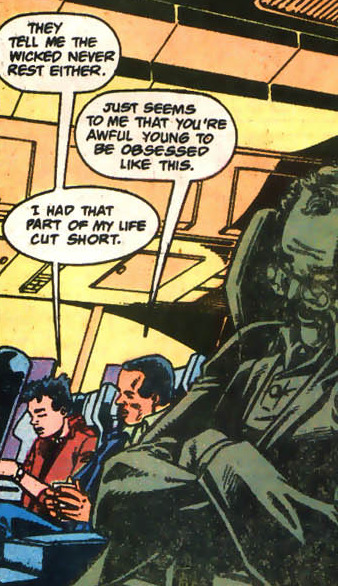
It’s a theme that gets hit harder and harder as more tragedies in his life hit him.
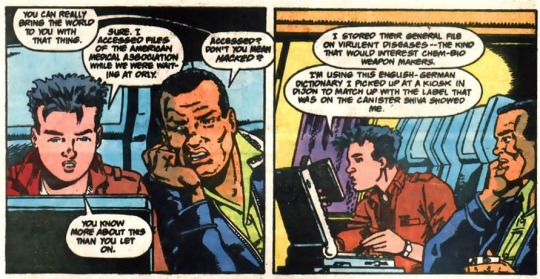
The child continues to use his handy dandy laptop to solve more crime, because he is one useful baby and--
Oh, I wasn’t joking about the plague stuff for a Spongebob reference.
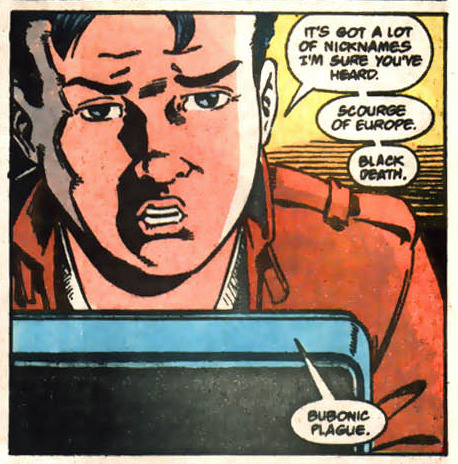
So I’m just waiting patiently for King Snake to start burning some crops.
--
This issue is better then I let on.
The character dynamics are good (when not forced), the pacing is great, the story moves at just the speed it needs to, and the character’s just keep getting fleshed out more.
It’s great stuff besides the weird forced romance stuff that’s annoying for the middle part of the issue, and Tim and Clyde’s chat about Shiva, like if that wasn’t there, this would be an issue I can’t really imagine having a problem with besides King Snake being lame, but that’s more of something that goes across all issues really. It’s not a this issue thing, although you can argue this issue should’ve done more to make him more entertaining over boring.
I even went back to find if there was any indicator that Tim has feelings for this girl, and beyond him melting at the first sign of affection. There’s nothing. He talks about saving her like it’s simply part of the job to him, the same way he talks about saving Clyde. There’s just nothing besides “girl and boy”, which is incredibly lazy and causes it to feel contrived.
In fact I just found more showing that Tim’s oblivious that people keep thinking more than what is.
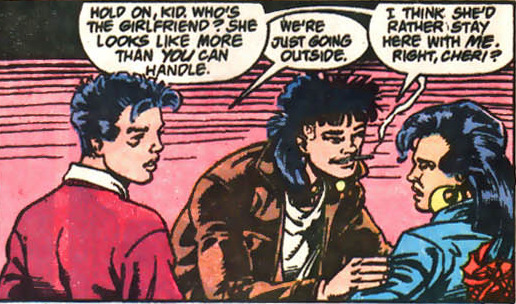
Like look at that. He’s confused why the jerk’s even saying “girlfriend”. This is what leads to him saying “this isn’t a good idea” when she starts getting flirty.
Tim’s not even remotely lovestruck.
As far as what’s shown he just loves affection.
I’m being repetitive about it, I know, but romance simply because “boy and girl” is dumb, and the fact that Tim actually isn’t interested in them as far as what’s shown and not just said by OTHER characters makes it more annoying.
Funny enough though, given how despite Tim shows no actual attraction to girl’s despite what the other characters assume. It actually makes it easier to interpret him as gay in this miniseries honestly. Cuz he’s going through the gay experience now even if the writer most likely didn’t intend that.
103 notes
·
View notes
Text
"okay but really? wonder boy?"
Request: Headcanons on Damian Wayne (Robin) and Jon Kent (Superboy) meeting Bobby Barnes (Wonder Boy)?
Note: Since @victoryfroststarlight requested it, I had to make it a priority - and even that was long. Also, I had to reread on Bobby and PLEASE love my new son, he's amazing.
Damian and Jon had finally become best friends - well, Damian called it trusted acquaintances but Jon knew better - and they'd gotten into the groove of working together due to their fathers.
They were even allowed out on missions together without supervision.
There were always some jokes of them finding a Wonder Girl to complete the generational trinity and sometimes the two felt like it was necessary that to be taken seriously as a duo, they had to become a trio like their family had done.
Dick and Donna didn't exactly have a Super but Jimmy Olsen was a trustee of the Supers and just as super as any Super that had ever well, super-ed. Jason had Artemis and Bizarro, Tim had Cassie and Conner, Bruce and Clark with Diana - Damian and Jon needed a Wonder if they were to be a proper group.
But when Diana arrived with a boy in tow, Damian and Jon didn't think that Bobby Barnes - a boy that looked way too fanboyish with his Wonder Woman themed skateboard - would ever be the key to it.
Not even when Diana named him as Wonder Boy.
"Seriously, Wonder Boy? Bit too 'distinctive'? Themyscira is women-only, you contradict everything they ever stood for."
"Damian! You can't say those kind of things!"
Jon always was the voice of reason out of the pair, a trait he'd seemingly inherited from Clark since Lois was often more chaotic.
Bobby himself didn't seem to fazed by Damian though, easily pairing him as the blunt type but he did often have an issue with Damian opening his mouth at the wrong times.
Jon and Bobby got on very well, both boys were easygoing and generally happy people, Jon fanboyed a lot over him being the first Wonder Boy unlike him and Damian who had predecessors while showing Bobby the ropes.
Jon also got excited for any shifts were Diana and Clark were covering the Watchtower or Hall of Justice as it meant for a chance to hang out with Bobby more - he even gave the tour of both after nagging Diana for ages to let him do it. It wasn't long at all before they became friends and went out on patrols together in Metropolis where Diana knew Clark would look out for Bobby and his rookie mistakes.
Damian was a lot harder.
And by a lot, it meant insufferable.
Bobby had tried to be friendly with Damian at a more passive rate than he did Jon, recognising that Damian was a lot more guarded and closed-off but he didn't expect for Damian to blatantly ignore him whenever the two crossed paths.
He'd hoped it was just the way of the Bats as Batman himself was often very careful around what he said while Bobby - or anyone - was in the room. But Nightwing, Red Robin, Spoiler and Static were generally very friendly to him and even Orphan and Red Hood were known to give him a wave or a greeting when they saw each other.
But in reality it was because Damian was jealous, though the boy would never admit it. The son of Batman and grandson of Ra's Al Ghul could never be jealous of a Wonder.
But he was.
He truly was.
Damian detested how easily Jon and Bobby had gotten along in comparison to him and Jon who argued and fought - he thought it was because it was both of them had ties to the trinity that they had fought but Bobby had Diana and the two still laughed and joked.
He was silently resentful when he saw or heard about the two on missions and it built up for a while before coming out in one huge speech after Superman and Wonder Woman had taken the two on a small space mission - nothing hard, it just allowed them a chance to take in the beauty.
Damian remembered Bobby looking surprised at the beginning before smiling, laughing about how he thought Damian hated him for nothing.
He remembered how Bobby apologised and asked for a chance to get to know Damian personally too on their own as he had done with Jon.
And Damian remembered his father telling him to make friends if he wanted to be sane in this world of heroism and he remembered how he simply told him to be at Gotham Clock Tower at midnight tommorrow and walked away.
And that was the start of a new trinity.
#dc headcanons#dc requests#dc imagines#dc x reader#damian wayne#robin#batfam#batman#jon kent#superboy#superfam#superfamily#superman#bobby barnes#wonder boy#wonderfam#wonder woman#new trinity#ask
90 notes
·
View notes
Text
I Review Lego Characters
I decided, for fun, I would review characters from various features and other bits I’ve seen in my research to more Lego brands. The brands in question have a heavier focus on non-toy media in this case, to narrow it down a bit. Because why not do that. This selection is grouped as the City folk aka any brand which is either focused explicitly around Lego City or could be argued to be heavily stemmed from it. For these characters, the following media pieces were looked at; Jack Stone, The Adventures of Clutch Powers, Lego CIty Undercover, Lego City Undercover: The Chase Begins, The Lego Movie and The Lego Movie 2.
I don’t have a specific way of giving characters ranks, I just go with what my instincts say. They give a gist of where they stand in my fondness for characters anyway.
And now for the big block of paragraphs;
Jack Stone - OG, he doesn’t have any daddy issues or love issues he’s just a good man who wants to use his creativity to help, boy scout probs, would protect. 7/10
Clutch Powers - Miner explorer dork who varies between stepping up as a respectable leader and being an excitable jokey buttmonkey, major daddy issues, gave us the perfect reaction shot to witnessing an unfortunate fetish victim. 8/10
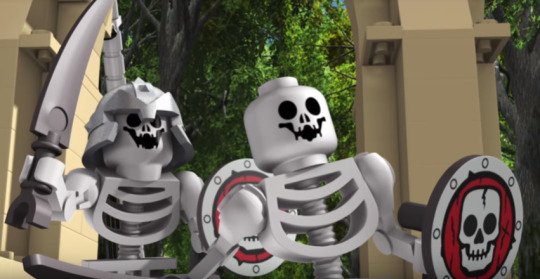
Peg Mooring - Started out like the typical stereotyped action girl, got better as the film went on, takes attacks from dragons like a boss. 5/10
Brick Masterson - HAAAAAAAAAAATE. 1/10
Bernie Von Beam - People think he’s just comic relief when he’s the closest to a normal man who just wants to do his job, takes dismemberment pretty well, just want to give him a hug. 8/10
Skelly and Bones - Goddamn they’re funny. 9/10
Mallock - Non-entity of a villain. 2/10
Chase McCain - Spends quite a bit of time being a cocky shitheel who also happens to be quite fun, would probably do crime if pushed, still somehow a dork who whines and gets trashed a lot, a bit on the dumb side, love not his strong suit. 8/10
Frank Honey - Precious baby, perfect comic relief. 10/10
Natalia Kowalski - Favourite of the love interests, she’s bitchy to the protagonist but it’s 100% warranted so it’s cool, neat character even outside of that dynamic. 7/10
Ellie Phillips - Pretty sweet even if she is mostly exposition and the tutorial person, southern drawl on point. 6/10
Chief Dunby - Basically just a typical angry police chief, he’s more plot key than character so this is forgivable. Gets pretty evil in Chase Begins though. 4/10
Rex Fury - Surprisingly pretty badass, could be in the running for most competent Rex even without raptors, still pretty fun, lacked a lot of screentime in LCU, devs realised this and made Chase Begins in response (which came out one month after the origin--wait, what kind of business decision is that???). 7/10
Emmet Brickowski - First film has him more balanced between typical “masculine” traits and cuter aspects, but generally came off as a more generic protagonist, second film pushes him as being more like Frank, and that is not a wrong choice, would hug. 7/10
Lucy aka Wyldstyle - Really generic in the first film, even bordering on dislike to be honest, the sequel allowing her more expressions and deconstructing her character as a whole did good stuff for her. 6/10
Unikitty - Two moods; “Is it working? Yay!” or “IT WAS PERFECTLY FINE WITHOUT RAISINS”, TV show version looks and sounds weird but doesn’t count for this ranking. 9/10
Benny the Spaceman - Is most interesting outside of spaceships, first demonstration of master breaking so must be a badass, SPACESHIP. 8/10
Metalbeard - Badass pirate man, the Lego version of the energizer bunny, having so many facets elevates him up despite being relatively downplayed, will one day make the pirate spaceship that should exist. 8/10
Batman - Ehhhh, not a superhero fan (MCU can get fucked), generally comes off pretty much just there, does get some of the best moments though. 5/10
Queen Watevra Wa’Nabi - Can slay me whenever, can’t say no to such a fun and bombastic character. 7/10
General Sweet Mayhem - Ends up being thrown to the side despite the prominence in marketing, she’s mostly just there, great dance moves. 5/10
Good Cop/Bad Cop - Don’t particularly like them that much to be honest, way overhyped for what was presented, Liam Neeson probably a boost at the time. 4/10
President Business - Most of his persona leaned hard into a stereotype but had fun with it, interesting implications both in-universe and on meta level pushes his character up. 7/10
Rex Dangervest - Cute man is broken into a nasty shitheel with dudebro arrogance out the wazoo, reptile themed. 10/10.
And that’s it for all the major city stuff (even if it does stretch the definition of city when you have aliens from another galaxy in there). Not sure if I might do a separate thing for the more fantasy-related brands (eg Ninjago, Nexo Knights, Legends of Chima etc).
Also if I do Ninjago any analysis would be movie only. I was exposed to that first and I’m not sitting through ten seasons of show just for like three sentences per character.
#VEDJ-F talks#a lot#jack stone#clutch powers#lego city undercover#lego city undercover: chase begins#tlm#TLM2#tlm2 spoilers#today I learned that lego has some weird stuff buried beneath its surface
15 notes
·
View notes
Text
Aquaman, Black Manta, and DC's Year of the Villain
https://ift.tt/2KKuOn8
Kelly Sue DeConnick told us what to expect from Aquaman and Black Manta during DC's Year of the Villain event.
facebook
twitter
tumblr
Kelly Sue DeConnick is a pretty big deal. Her creator-owned work has won her, among other accolades, a Hugo nomination and a British Fantasy Award win for Bitch Planet, the brutal political satire exploitation book she did with Taki Soma and Valentine De Leandro; and an Eisner nomination with Emma Rios for the staggeringly beautiful mythic western, Pretty Deadly. But it’s her work with Carol Danvers that you’re most likely familiar with. Her time writing Captain Marvel made the character one of the biggest superheroes in comics, and paved the way for Carol’s absurdly successful film earlier this year.
So when she made the jump to DC (along with Legion of Super-Heroes reboot mastermind and current steward of the Superman titles Brian Michael Bendis; current writer of the best Superman book in years Superman’s Pal Jimmy Olsen Matt Fraction; and new Wonder Woman mythmaker, G. Willow Wilson), it was the sign of a massive change for the line. DeConnick took over as writer on Aquaman with December’s #43 and set about building a world around Arthur on land, while leaving plenty of trouble back in Atlantis for Mera to deal with. We had a chance to sit down with her and talk about her time building up Amnesty Bay, Aquaman’s unique power set, and why Black Manta is both the perfect villain for Aquaman and a deeply, profoundly messed up individual.
This interview has been lightly edited for clarity.

Den of Geek: Early on you defined [Aquaman’s] signature power is the ability to ask for help. Is that kind of the overarching key to the narrative here?
Kelly Sue Deconnick: I don't know that I think that's the central thesis. I do think it is a thing about him that I find fascinating that I don't think has been explored. The “heavy is the head that wears the crown” thing has been very explored. I don't know what new thoughts I have to bring to that aside from the fact that it's kind of interesting to see Mera battling with that right now.
But I do think if we're kind of looking at for what hasn't been done, what is rich to be explored with him, and also I think what has often been treated as something that's problematic about him. But I think it doesn't have to be, shouldn't be, and is in fact really interesting, is the fact that his signature ability is this ability to ask for help where he is also just a classically masculine character. Those two traits can sometimes be treated as incongruent. The tough guy doesn't ask for help.
read more: Batman Universe is a New Kind of Dark Knight Story
I think that what's interesting is when we're sort of picking apart the idea of what makes a natural leader. So, one of the ways that they've played with the signature ability in the past is…it’s not that he talks to fish because that would just be ridiculous. He can control them because their minds are really small, but I don't think controlling another living thing is a heroic ability. I think that's a villainous power. Regardless of the depths of the mind of the thing that you're controlling, I think controlling something that has a will of any kind... I think that's villainy.
Right. Coercion or control is the easy way out, right? The inspiring thing to do is to convince a bunch of people to see your way.
Yeah, and the idea being that you have to be in this for the right reasons. They have to trust you, you must have a higher goal in mind in order to have everyone come to your aid.

What made me think that that the ability to ask for help was maybe one of the theses that you were building around was the community that is kind of forming around Arthur in Amnesty Bay. You've got all of the powerful water gods, you've got Aqualad back with him. But, it feels like if the ability to ask for help is what defines him as a hero, it feels like you're setting up a lot of people who are willing to give him help if he asks.
Yes, absolutely. I'm also playing in this particular arc with the idea of forgiveness. I mean, the town is called Amnesty. All of the people that we've sort of pulled in here are people who have struggled on either side of needing to forgive or needing to find forgiveness, which sounds super action oriented and punchy [laughs].
But the thing about superhero stories is finding the humanity in them. It can't just be about pretty costumes bouncing around the page and cool action sequences. Cool action sequences and pretty costumes bouncing around the page are vital components of the genre and they need to be answered, but there also has to be something that transcends that, that's human that we can all relate to in order for us to make the connection that makes it resonate. And so, it's a little bit of a puzzle. And this is something I've worked with before because Carol Danvers is not a thinky heroine. She punches shit. You have a problem, Carol would like to punch it.
But you find the themes in there that resonate, that transcend just the action sequences, and even in the action sequences. Even when you're choreographing the action sequences, you're still looking for ways to... The same way that Stanislavski trained actors to look for psychological gestures to mirror what's going on inside the character, we're looking for that on the page so we can find the ways to make it have a capital T truth to it, make it have something that resonates for us.
read more: Aquaman Comics Reading Order
Mera and Arthur are in a place right now where each of them needs to forgive and each of them needs to ask for forgiveness. They're so strong and so proud that neither one of them wants to be the first one to do it, and they have a ticking clock in the form of a child coming. That's real and human and it's not perfect. It's beautifully flawed and the kind of thing that you don't need to be bulletproof to understand that feeling.
It sounds like you're setting up Black Manta to be kind of the third point of the triangle there, with the needing to forgive and too proud to do it and-
Completely unable to.
Exactly. Right, and letting that kind of consume him. Does he fit in your head as the ur-Aquaman villain?
Oh absolutely. In contemporary Aquaman, the two big villains he has are Orm and Manta, and I was given the directive that they wanted him out of Atlantis for a while. That Atlantis and Atlantean politics had been well covered. It was an excellent storyline, and we needed to remind the readers that he was part of the DC universe on Earth, and we really need to make Amnesty Bay a place that feels like it has a sense of place as much as Gotham or Metropolis. Amnesty Bay should feel like a place we know and recognize. We know the characters that live there. When I say Metropolis or Gotham, you know exactly what I'm talking about, right? So Amnesty Bay, you should have that same sense of place and the characters that populate that place.
read more: Every DC Comics and DCEU Easter Egg in the Aquaman Movie
So we're really trying to build this. And so if the directive we've been given was to tell stories with him in his world on land, Orm doesn't make sense as the primary villain there because Orm doesn't really... With the exception of when Orm flirted with being a good guy for a little while, which I thought was fantastically done, it's one of my favorite Aquaman stories in the last few years. But his concerns are all Atlantean. So, if Arthur leaves Atlantis, Orm is delighted, he does not give a shit. He's not going to come after him. There is nothing that matters to him there. Now, the child might change that.
Hint hint.
MIGHT. I don't know, we'll see.
But if we're talking about Amnesty Bay, and land-based stories, then Manta is just the obvious go-to. And he's such a great character, such a great character, it's not like "Oh damn." It's like "Well great, fantastic. I love him." He's one of those people that, they say resentments are like drinking poison and expecting the other person to die. And that's him. He is just everyday drinking poison.

And now we get to drive the mech around.
Yeah. Well, kinda.
It's a little bit better than drinking poison.
Yeah. And the Mech is programmed to be like getting his dad back. There's a lot to play with there too because that's a complicated relationship.
And it's from Luthor, so obviously there's going to be some catch to it.
When we were talking about the villain offers [happening across the DC line as part of this month’s Year of the Villain tie-ins] and it was like, there is literally nothing... There's no fire power, there is literally nothing that Lex could give him that he would give a shit about. He just doesn't care. You want to give him something, he'll take it, but he's not going to make a deal with you for it. Because there's just nothing that's worth it to him. The only thing he would really want is his dad back and you can't give him that, and then it was like "Wait, could you?", and then that became interesting - what happens if you get what you asked for? And when you get what you're asked for, Lord protect me from what I want.
read more: Year of the Villain Leads to the Biggest Event in DC Universe History
Maybe having his dad back isn't exactly what he thought it was going to be. I just had this notion that he got his dad back and his dad wasn't exactly what he wanted. And then he'd remember that like "Oh no, his dad didn't respect him the way he wanted his dad to respect him."
...He fusses with the AI, basically reprogramming the father figure to be the father figure he wants. Which, it's really fucked up and incredibly human.

So what's Robson Rocha been doing art-wise that made you go "Shit, I should probably give him more of that to do?"
I spoke to him in the very beginning. I looked at all of his work when they were trying to make a pair for us, and suggested Robson, and I looked at it, and it was like "Oh, this is big, epic stuff." So, this is kind of like, we've got to start thinking. We got to think big and epic, and then I talked to him and I was like "What do you want to draw?". He was like "Monsters." I was like "Alright! I'm in." So, big, epic monsters. Cool. And he has just been killing the monster thing.
The thing that I discovered though that was fascinating was he's really, really, really good at that, but most artists that I'm familiar with who have that kind of giant epic scope and can do those big sort of airbrushed-on-the-side-of-a-van kind of scenes, that is where all of their energy goes and they're not as good at the small human acting moments. He is.
read more - Aquaman Villains Explained: Who is Black Manta?
He's incredibly good at the small human acting moments, and in fact handles humor beautifully well and the Aqualad introduction. His take on Aqualad and his expressions and even his face, I asked him. I was like "Are you using a model for this kid?" because there's a real specificity to his facial structure. He doesn't look like generic dude.
[Aqualad] exists in space. That construction of his skull stays no matter what. I know we're talking about basic drawing here, but it's not something... It's rare actually to have someone who is that distinctive looking and it's not model-based, and he's like "Nope, just comes out of my head.". I'm like "Oh, okay. You're a genius. Neat."

Yeah, when Aqualad follows Arthur into the water the facial expression, the way that his face is just flopping around on his skull is really like anime humor.
It’s just fantastic. He can do the humor without undercutting the stakes of the action, and that is a gift. So, he is just a complete delight to work with, and he is crazy fast. I feel like I'm being chased. I don't know how he is both that good and that fast.
What's been the toughest thing about Aquaman and Atlantis to crack, and what's been the most pleasant surprise now that you're kinda into it?
It's always hard coming in when you're writing these characters that have these long histories, and I think coming in at the time of the movie and making the book welcoming to the movie viewer, and also not alienating to the longtime fan. That was hard. Also, just getting him... He's a tough guy. He's not chatty. Getting him to kind of open up to me and I'm sort of learning who he is. That was hard. The supporting cast helps with that a lot.
read more: Everything You Need to Know About Aquaman 2
Also, just having the longtime fan base trust me that I don't hate Mera. I love Mera, I love their relationship, but adult relationships can be complicated. I think they are one of the definitive relationships in the DC universe, and I believe they were the first married couple too, which I think is really important. I've no interest in making their love story go away. I am interested in complicating it because human beings are complicated, and I think that makes it more important and more real.
Once we get some of this stuff wrapped up, I want to play with format a little bit. I want to do some more contained stuff. I want to see if I can figure out a way to do some of that. So, the X-Files model where you have these done in ones, but then you also have like larger storylines.
Read and download the Den of Geek SDCC 2019 Special Edition Magazine right here!
facebook
twitter
tumblr

Interview Jim Dandy
Aug 21, 2019
DC Entertainment
Aquaman
from Books https://ift.tt/2Nqy1Kb
0 notes
Text
The Necessary Feminization of Heroes
The rise of superheroes is a phenomenon worth studying in its own right. The birth of heroes like Superman and Batman came at a time of great unrest in history. World war II was looming, and the threat of atomic annihilation was on everyone’s mind.
It’s no coincidence that the more recent popularity of superhero films began at a time of great economic unrest. We revived the old heroes, longing for a previous stability that had been lost.
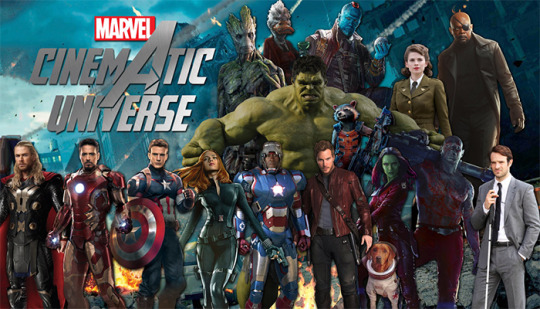
The initial hype for the films was exciting, but most of that excitement seems to have fizzled off. Some blame the mediocrity of the films, but perhaps it’s because of a limited concept of what a hero can be.
They all seem to be cardboard cutouts of the same concept: a punchy do-gooder. Sometimes writers try to throw in some angst or romance to make it more interesting, but it doesn’t help much. There’s little character development, because we already know what the “hero” is supposed to be.
Their job is to be the lone ranger that punches the bad guys to save the victims. That’s all. Their work consists of punching and shooting. Nothing else.

The individuals they save play no role and have little identity besides being a helpless victim to be saved.
The plot becomes predictable because we know that no matter what, the hero is going to find a way to punch/shoot the bad guy. The villain will do nothing except get punched, the victim will do nothing but be saved.
That’s not always a bad thing. Sometime formulaic stories are enjoyable, like in detective dramas. I’m also not on an anti violence tirade. I’m just saying that interesting characters should have more, and a “hero” should have a wider definition.
One of the contributing factors of this homogeneity is the fact that most of our heroes bear masculine traits*, regardless of the individual character’s gender (more on that later). It’s possible, however, to have a hero that bears feminine traits, and it completely changes they way they relate to their world.
*When I mention the masculine and feminine, I don’t want to refer to stereotypes or some kind of idea that all men are/should be X or all women are/should be Y, nor am I talking about about gender identity. I’m speaking in the archetypal, conceptual sense, referring to a set of traits that have been traditionally labeled masculine or feminine. This is not indicative of individual, unique humans. This is purely conceptual.
The Masculine
The masculine hero is something nearly as old human civilization itself. One of the first heroic tales, The Epic of Gilgamesh, dates back to 6000 B.C. and describes a hero with the typical masculine traits that we still see today.
The typical masculine hero is:
- Individualistic (I can do it on my own, I don’t need others.)
- Brash, foolhardy, lots of dumb risks
- Brave in the face of danger
- Relies entirely on brute strength and audacity to make his way in the world
The usual endgame of the typical hero is a good deal of destruction (as long as we smashed the bad guy too, we’re good). They smash their way out of trouble and solve all their problem by punching, shooting, or blowing something up, usually through very stupid decisions.

There is an ongoing theme in a lot of superhero stories that being a hero is incredibly isolating and solidly detrimental to the individual’s relationships, though it’s not always clear why that is necessary. The hero tends to view him/herself as qualitatively separate from “victims” and does not delve much into their lives. They are merely there to be rescued.
Heroes (while in hero mode) seem to have little concept of how to interact with other people, and often switch into a hyper aggressive mode that can even turn heroes against each other.
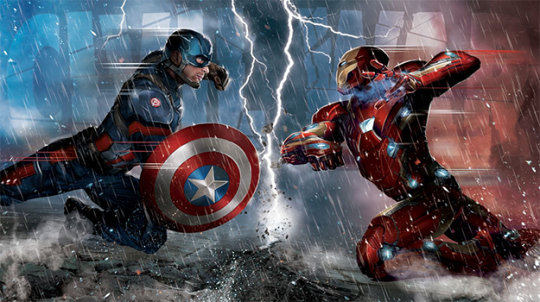
Why is it that heroes are inescapably linked to aggression, to the point where studios are handing us films in which the heroes are fighting each other for seemingly no good reason?
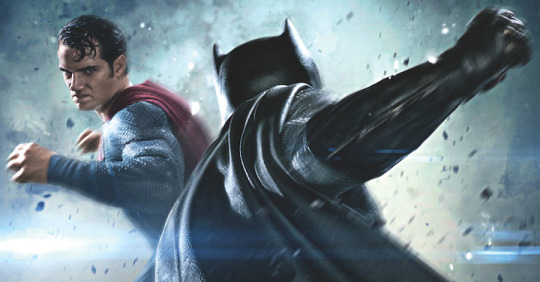
Additionally, there’s no place for this kind of hero during peacetime. What do they have to offer when things are going well?
The long term outcome of this kind of heroism is not very effective. How is one man dressing up as a bat and beating on criminals going to change anything?

What if we had a hero that did not rely on rash, foolish decisions and brute strength? What if we had a hero who did not just rescue victims but empowered them to save themselves?
Suggestion: What if we had a feminine superhero?
The Feminine Hero.
The feminine hero is a nurturer. They conquer and defeat through cunning, planning and cultivation rather than brute strength.
Traits of a feminine hero: - Does not isolate themselves. Their relationships with others are a key part of their work - Saves through nurturing and empowering - Relies on tact, intelligence and cunning rather than brute strength and rash decisions - Unafraid to use violence or do hard things when necessary - Continues to develop their community outside of crisis situations
My model for this concept is Carol from The Walking Dead. She’s managed to save the group and defeat the bad guys several times over, but never in the traditionally masculine way. She embodies the archetypal traits of a nurturing mother, while still managing to be a total badass.*

Case Study: The Walking Dead Season 6, episode 2: “JSS”
In beginning of this episode, the community is at peace. Carol can contribute and build up a community outside of a major crisis, but when a crisis comes, she knows what to do.
Murderous people invade the community while Carol is in the midst of baking a casserole and watching a baby. Instead of taking on a simple motherly role and protecting the baby from the invaders, she hands the more than capable teenage brother a semi automatic and leaves to go be a hero. The following is where the real distinction lies.
A masculine hero (like Rick, the show’s male lead) would have whipped out a big gun and stormed the bad guys, killing them all and rescuing the poor victims cowering in their homes. Carol does not do this.
She refrains from drawing attention to herself, kills without remorse when she needs to,

and disguises herself so she can move freely without gunning her way through the village.

She has a plan, a goal, and is carrying it out with tact and precision: Give everyone their own guns.

Her goal is not to obtain the macguffin or blow up the key location, but to empower others. She reaches the armory, fills a tote with guns and hands them out to all the no-longer-cowering “victims”.

The invasion is ended very quickly by empowering those under threat to save themselves. It’s a primarily “motherly” action, to nurture and strengthen others to the point where they don’t need you anymore.
There is minimal damage to the community because there was no big firefight or show of brute force. Victims are no longer faceless and helpless, creating an entirely new dynamic between the “hero” and the “victims”.

This is my proposal for a feminine hero.
*My favorite part about Carol is that she isn’t a 22 year old stripper ninja. Her main purpose isn’t to appeal to men. She saves everyone’s life as best she can, and doesn’t have to be a sex object to do it.
How does this affect gender?
It’s important to note that the masculine hero is not limited to men. Women fill this role easily, but not always with the best results. The problem with most female heroes is that they are not allowed to be anything more than the typical brash, violent and sexy cliche (I like to call it the “bossy stripper ninja”). They are not given distinct personalities, or complex motivations. They are merely “punchy”.
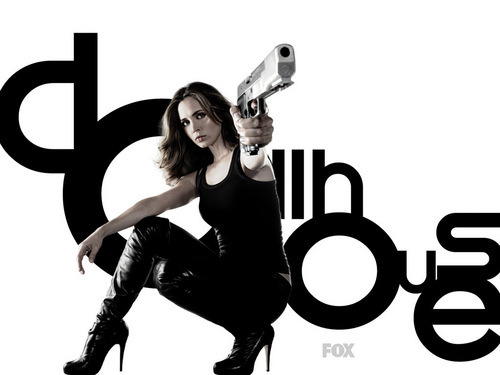
Who needs a deep, rich inner life when she has guns?
There are some notable exceptions. Buffy, for one, was allowed to be human, complex, AND punchy.
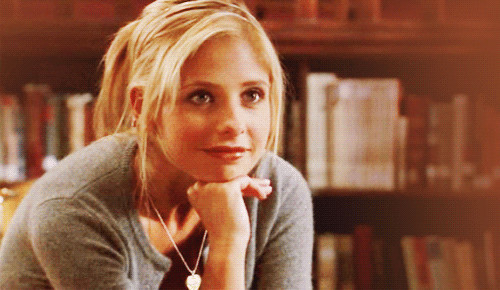
Most that have come after her have not been given the same generosity. The problem is, after the writer decides that a woman is “punchy”, they give up. They give her nothing else. We are hard pressed to describe this character apart from her appearance and her weapons.

Conversely, there are a number of examples of men that are masculine in character but feminine in role. That is, the individual possesses masculine traits in their personality, but they interact with the world through feminine traits (cultivation, patience, planning, etc).
The problem is, most of these examples seem to be villains. We can make a man function in a feminine way, but somehow it usually makes him a bad guy. I’m having trouble coming up with a single example of a male hero that functions through feminine traits.
Villains seem to be the only ones with tact and precision, who cultivate a world into their own vision and develop others rather than just knocking them down. They have henchmen, converts, and their own little community. Unlike heroes, they don’t stop working when there’s nothing to smash.
Examples:
Loki has a good amount of feminine heroic traits, as do most villains whose goal involves something other than blowing up the world. He is cunning, patient, and has emotional depth.
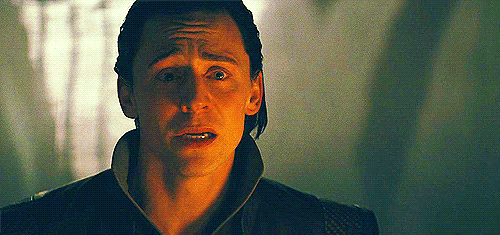
The fact that he experiences emotion doesn’t diminish his strength or power in any way.
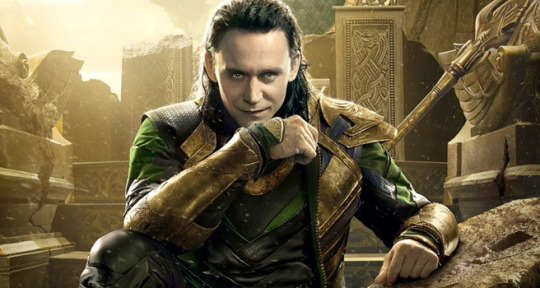
2. Another good example is Wilson Fisk (of Marvel’s Daredevil). He’s a large man who can easily be nothing but evil and punchy, and instead possesses a rich and complex inner life and a fantastic sense of aesthetic.

Although he has his physical rages and is incredibly physically strong, he succeeds through intelligence, subterfuge and subtlety and cares deeply for those around him (beyond the typical best friend and love interest).
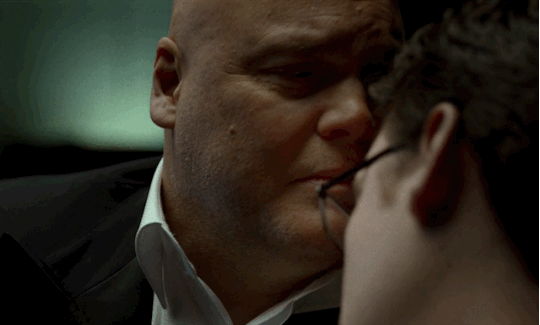
He’s a very masculine character, but feminine in his villainy.
3. Frank Underwood is crafty, patient and ruthless. He is a terrifying villain, because of his ability to manipulate others, stay one step ahead of everyone, and think his way out of trouble.

Writers seems to be doing a very pretty good job in developing interesting (and feminine) villains, but haven’t given us much variety in heroes. How many of us have questioned ourselves for being far more interested in the villains? It’s because they are genuinely more interesting!
Wouldn’t it be more interesting or effective if superheroes actually got to know those they were protecting? What if Bruce Wayne befriended those who were at risk of becoming villains? What if he educated each citizen of Gotham concerning every supervillain’s weakness?
This doesn’t even take into account other important issues surrounding heroic stories, like moral ambiguity, the objectification of women, and the lack of depth in heroic characters regardless of Masculine or Feminine traits. I’m just saying we could use some variety in character traits. As Carol shows, it doesn’t make for a less interesting story. The conflict is still there. It just gets a whole lot more nuanced. We’ll always need smashy punchy stories, but can we please develop a little variety?

#fandom#feminism#marvel#dc comics#superheroes#the walking dead#carol peletier#when you make a man feminine he automatically turns into a villain#its science#my meta
7 notes
·
View notes
Text
Best Games for Laptops and Low-End PCs in 2020
When I first became interested in computers, the idea of gaming on a low-end laptop or desktop was a contradiction in terms. Your options were: Intel, if you could afford them, AMD if you needed a cheaper but good-enough option, and Cyrix if you hated yourself. In the modern era, we aren’t nearly so constrained. Modern games target every type of device and form factor, making it comparatively easy to find titles to play.
We’ve rounded up some of the better ones below.
In this list of our favorites, we’ve tried to blend a mixture of modern titles and a handful of older classics. If you’ve been gaming for a number of years, we strongly suggest Googling “best games of X,” to remind yourself what hidden gems you might have missed the first time around. A game that required a midrange PC to play in 2011 likely runs just fine on an integrated GPU in 2019, especially if you’ve got an Ice Lake-based notebook or Ryzen Mobile 4000-based laptop. Integrated graphics don’t have to mean unplayable games.
The PC gaming news cycle often doesn’t serve the interests of the larger PC gaming community when it comes to game discovery. This is particularly and sadly true for low-end gamers. Lost in the endless churn of new titles is the fact that there are literally thousands of amazing PC titles released long before you bought your system. Don’t be afraid to go digging for gems you might have missed in previous generations.
One way to express a love of PC gaming is certainly by investing lots of money in gaming hardware, but it’s certainly not the only one. What matters isn’t the amount of money you can plow into the hobby, or how new the games are, but whether you enjoy them.
This time around, I’ve added a “Runs on” listing to give the minimum specs for the game. I cannot guarantee how good the experience at the minimum spec is, but this way you can eyeball games and get a sense of whether your hardware can run them.
All games should be assumed to require Windows 7 or above unless specifically stated otherwise.
Poly Bridge
Your Inner Civil Engineer Requires: Pentium 4 2GHz, 2GB of RAM, GeForce 7200 GS, 150MB of storage.
Poly Bridge is a great puzzle game, somewhat in the tradition of now-ancient titles like The Incredible Machine. In this case, you must design bridges that can carry a certain number of vehicles while also coming in under budget. These two simple goals can be difficult to achieve in later levels (there are more than 60), since the game adds various hazards and the need to deploy construction techniques I’m fairly certain the Army Corps of Engineers does not approve of.
The game recently got a sequel (which I haven’t played yet). Reviews of it seem a bit less enthused than for Poly Bridge, with one noting it felt more like an expansion pack to the original. It is, however, excellently rated on Steam.
Disco Elysium:
Stagger Drunkenly at an Adequate Frame Rate: Intel Core 2 Duo, 2GB RAM, 20GB HDD space, 512MB graphics card.
In Disco Elysium, you’re an alcohol-and-drug-abusing amnesiac detective who has been hired to solve a murder mystery. This sort of thing happens so often in games, you’d think there’d be some kind of agency in charge of ensuring would-be detectives still knew their own names.
As you work to solve a murder you’ll remember things about yourself as well and have access to a system of traits with which to flesh out your character. There are 24 skills in the game, and they all have an impact on how the game evolves. Pick the wrong (or right) ones, and you may end up arguing with yourself over the correct course of action. It won Game of the Year from several publications, and it’ll run on 14-year-old hardware.
Mutant Year Zero: Road to Eden
Search for Scrap On: Core i5-760, Phenom II X4 965, GTX 580 / AMD Radeon 7870 HD, 6GB RAM, 8GB HDD.
This XCOM-meets-Fallout title is based on the tabletop Mutant Year Zero game. If you’ve played the modern XCOM games, you’ll be familiar with most of the gameplay elements, though Mutant Year Zero gives you direct control of your squad outside of combat and fuses XCOM’s gameplay with some light RPG elements.
The worst thing we can say about Mutant Year Zero is that you’ll have to do some Googling to figure out which buttons are tied to which keyboard functions. The game’s plot and post-apocalyptic setting recall the best parts of Fallout, and while the game isn’t as deep as one of those sprawling titles, it still feels like a spiritual sequel. Mutant Year Zero: Road to Eden feels a bit like a “AA” game, for lack of a better phrase. Reasonably well-polished with solid aspirations, but you won’t mistake it for a 400-hour dungeon crawler.
World of Warcraft Classic
Visit Beautiful Molten Core if You Own: Is your PC literally old enough to vote? No? You’re fine. Officially, Core 2 Duo E6600 or AMD Phenom X3 8750, 8800 GT or Radeon HD 4850, or Intel HD Graphics 4000. Unofficially, you can run probably run Classic on less. I’ve tested it on a 2015 Razer Blade Stealth with Intel 520 HD graphics and the frame rate was high enough to make me think there’s some headroom in those already-low-end graphics options. Interestingly, WoW Classic isn’t listed as requiring a DX11 GPU.
Lakeshire, Redridge Mountains. Left is Retail, right is Classic.
Revisit a simpler time, when an MMO that largely takes place outside and requires you to congregate with large groups of people didn’t feel fantastical (at least not for those reasons). WoW Classic is everything you loved (or hated) about original World of Warcraft. I’m a biased fan, to be clear, but just because I’m biased doesn’t mean I’m wrong.
It’s World of Warcraft: Classic, which is to say, #NoChanges (except for a few of the changes, but really, there aren’t that many). There’s a lot to love in the original version of Blizzard’s MMO classic, especially if you like games of this era in the first place. It may use the modern WoW engine, but Blizzard re-used original WoW’s textures and assets. The result is a game that runs just fine on a low-end PC, including Carrizo-powered AMD ultrabooks and Intel integrated graphics.
Alternately, you could pick up Runescape Classic, which literally runs on mobile phones now. Your move, Blizzard.
Untitled Goose Game
Chase People Like an A****** With: Core 2 Duo 8500, Nvidia GeForce 510, 4GB of RAM, 820MB storage. The 510 is a bottom-end card from 2011, which means midrange or high-end cards from 2011. As long as your GPU can handle DX11, you’re fine.
Untitled Goose Game challenges you to find the Canadian goose inside yourself. Yup. This is a game about being an unrepentant asshole. Since the joys of honking and flapping don’t require a high-end PC, Untitled Goose Game is another game that’ll run on just about any toaster you can drag out of storage.
Honk. Flap. Steal objects, trick humans, annoy pets, wash, rinse, and repeat if necessary. It’s a brilliant game for people turned off by “typical” titles looking for a silly, funny, low-key experience.
Arkham City
Soars Through Gotham On: Any dual-core CPU at 2.4GHz or more, Nvidia 8800 GT or AMD Radeon 3850, 2GB of RAM. Supports Windows XP.
I’m sticking with Arkham City in this update, rather than moving on to one of the newer titles. Arkham Asylum is, to be sure, still an excellent game, and it runs on an even lower-spec system than Arkham City. But between the two of them, Arkham City is the better overall Batman game. Batman’s overall bag of tricks gets polished and AC offers you playing time as characters like Catwoman, with her own distinct moveset and animation style.
Arkham City feels as though it genuinely captures what it would be like to “be” Batman, with a clever twist on why you face a never-ending army of thugs. If you want to find out if you’re going to like the Arkham game series, I’d say this is the best one to try. If you need something even gentler on system specs, try the original Arkham Asylum.
Into the Breach
Calculate Strategic Micro-combat Using: Any 1.7GHz CPU, 1GB of RAM, 300MB storage, and an Intel HD 3000 IGP.
Into the Breach is a turn-based strategy game that takes place on small maps of 8×8 grids. From the makers of FTL, Into the Breach challenges you to beat back waves of attackers in turn-based combat. There are no XCOM-style probability fields to deal with here — you get full transparency into what actions will be taken by both your own characters and the enemies you engage with.
Into the Breach launched in 2018, but it’s still winning recognition for its unique approach to turn-based combat today. Definitely worth checking out, if you’re looking for some turn-based combat options.
West of Loathing
Spittoon-and Snake-Themed Exploration Needs: An Nvidia GeForce 7200 GS, Core 2 Duo 7400, 2GB of RAM, and 4GB of storage. Runs on Windows XP SP2+.
West of Loathing is a “graphical” adventure game that could run on a Lite-Brite. Don’t let the black-and-white stick-based graphics fool you — under the hood is a classic adventure game with RPG elements, killer clowns, demon cows, snake oil salesman, and a heap of spittoons to dig through in search of loot. The dialog is laugh-out-loud funny and the game’s irreverent humor recalls the best adventure game writing of earlier eras.
West of Loathing came out at the end of 2017, but it’s still a top pick if you need a game that runs on anything and offers some genuine laugh-out-loud moments.
Stardew Valley
Want to Farm Crops and Help People? You’ll Need: Any CPU at 2GHz or more, any GPU with at least 256MB of RAM and SM 3.0 support, 2GB of RAM and 500MB of storage.
Stardew Valley was heavily inspired by the Harvest Moon series of video games but adds its own spin on the concept. Explore Pelican Town, make friends, fall in love, and restore your grandfather’s farm to health in a gentle, open-ended title that will tease your curiosity as opposed to yanking you hither and yon with frantic quest demands.
Stardew Valley received a major endgame update last fall in Patch 1.4, with new monsters, fish ponds, a new mystery to solve, various bug-fixes, quality-of-life improvements, and similar updates. Multiplayer support is also now available.
Cuphead
Visit the Era of Classic Animation (and Try Not to Die) if You’ve Got: An Intel Core 2 Duo E8400, AMD Athlon 64 X2 6000+, 2GB of RAM, Nvidia GeForce 9600 GT / AMD Radeon HD 3870, 20GB HDD space. Only needs DirectX 9.0c support, but still requires Windows 7.
Cuphead’s visual aesthetic is truly unique — it’s the only game we’ve ever seen that mimics the “rubber hose” animation style of the early 1930s in a frenetic 2D game. You’ll need sharp reflexes to beat the game, but not much in the way of PC horsepower.
Cuphead is a great game for someone looking for a game you might fairly call “Nintendo hard,” particularly if they enjoy its animation.
Minecraft
Fend off Creepers and Illigers With: A Core i3 3210 or A8-7600, 4GB of RAM, 180-1GB HDD space, Intel HD 4000 or AMD’s Radeon R5 family, and a 1024×768 display.
The open-world sandbox of Minecraft has been used to create everything from 1:1 scale models of the starship Enterprise to functional (if simple) CPUs. In between, there’s an easily accessible game with a rich crafting system, dangerous mobs, and huge worlds to explore. If your ideas of gameplay run more towards “give me a big space and lots of tools,” and less towards coherent narrative and story-driven play, you may find Minecraft much to your liking.
That doesn’t actually tell you nearly enough about Minecraft, a game that’s inspired millions of people to spend billions of hours stacking blocks on top of each other. Minecraft is a phenomenal crafting and building game.
Orcs Must Die, Orcs Must Die 2
Revisit the Simple Joy of Spring-Loaded Traps and Acid Bombs: Any dual-core CPU at 2GHz or above, a GeForce 6800 or ATI Radeon x1950 with 256GB of RAM, 2GB of RAM, and at least 256MB of VRAM. Supports Windows XP.
I recommend both, but OMD2 is definitely the better game.
Orcs Must Die and Orcs Must Die 2 are some of our favorite titles for mindless slaughtery goodness and have a permanent space on my hard drive. This hybrid tower-defense/action game tasks you with burning, blasting, freezing, smashing, dissolving, shooting, and generally wreaking mayhem against wave after wave of orcs, trolls, ogres, and other various bad guys. It’s easy to learn and sometimes surprisingly difficult to master.
OMD excels at offering a variety of fun ways to slaughter monsters in quick succession. Spring-loaded traps that hurl creatures through the air? Check. Acid sprayers and arrow traps? Check. Trinkets to transform you into a massive ogre, hurl fireballs, or turn orcs into chickens? Check.
Darkest Dungeon
Explore Your Ancestor’s Darkest Secrets: 2GB of RAM, a GPU capable of supporting OpenGL 3.2 (released in 2009), 2GB of storage. 1080p, 16:9 displays recommended.
Darkest Dungeon is a 2D, side-scrolling dungeon crawler with a side helping of Lovecraftian horror (hold the racism) and a mental health management simulator. As your heroes wind their way through the stygian abyss, they’ll face the dripping claws and rasping moans of the eons-damned creatures that dwell beyond the stars. Safeguard them carefully, or you’ll find the abyss staring back at you when you least expect it…
Darkest Dungeon can be legitimately annoying, but if you love mods like “Longest War” for XCOM, this series is a treasure. DD doesn’t pull punches, and if you think you’ve figured the game out, that probably means there’s a DLC or difficulty level waiting to kneecap you around the corner.
So that’s our list. Feel free to chime in with your own. What older games or titles still have a cherished spot on your hard drive, and what games do you find yourself returning to, long after they’ve supposedly been surpassed by more recent releases?
Now Read:
Microsoft Flight Simulator Ships on 10 DVDs
Report: Nvidia Ends Production of RTX Turing GPUs, Ampere Is on the Way
Microsoft Details How the Xbox Series X Achieves Its Storage Performance
from ExtremeTechExtremeTech https://www.extremetech.com/gaming/269774-best-games-you-can-play-on-laptops-and-low-end-pcs from Blogger http://componentplanet.blogspot.com/2020/07/best-games-for-laptops-and-low-end-pcs.html
0 notes
Text
Have We Learned Nothing? – A Sixers Column
Bitch, whine, moan.
Sob, fret, complain.
Gripe, grumble, cry.
That’s what I heard from MANY – not ALL – but MANY Sixers fans on Saturday night, the entirety of Sunday, and also Monday morning when I reluctantly opened Twitter.
I’m willing to bet that the loudest complainers were anti-Process types who just came back to the bandwagon this year, set unrealistic expectations for a squad featuring a rookie point guard, second-year center, and second-year power forward, then went off the deep end spitting nonsense after a team with zero playoff experience failed to meet the outrageous goals that THEY THEMSELVES set.
Take a breather.
The Sixers are down 3-0 to a better team with a better coach as of May 7th, 2018. Ben Simmons, Joel Embiid, and Brett Brown have disappointed under the brightest glow of the still-nascent spotlight. There’s no disputing that. I think everyone is in agreement that the coach and the two stars have underwhelmed, though I’d also extend that to Dario Saric and Robert Covington and a number of the veterans who have actually been here before. Nobody is blameless.
Does that mean that the players suck and the coach should be fired and the general manager should resign? No, of course not. It means that the more experienced team with the more experienced players (minus future superstar Jayson Tatum) simply took round one in what will inevitably become the Eastern Conference’s premier rivalry over the next half-decade.
That’s it. That’s the explanation. That is William of Ockham’s razor.
Yet here we are, doing what Philadelphia always does, and proclaiming the franchise dead and buried and flattened to the point of no return.
“They’ve been EXPOSED!” is a local favorite.
Can we please stop using that word? He got “exposed.” She got “exposed.” We say it as if coaches and players and executives can never evolve or learn or adapt, as if once a flaw is exploited, it always remains.
There are a million examples of people who were once “exposed” but figured it out and turned it around. Doug Pederson and Nick Foles come to mind. How about LeBron James? Jared Goff? 2004 Drew Brees vs. 2003 Drew Brees? Even Sergio Garcia won The Masters.
Of course the counterpoint to that is Byron Maxwell, so I’ll give you that one, but let’s continue with the Eagles theme.
These knee-jerk, “fire everyone” types are the same fans who became so irrationally flustered when the Eagles hit the wall after starting 3-0 with a rookie quarterback and first-year head coach. That pair, Pederson and Carson Wentz, won the franchise its first Super Bowl the very next season. Same thing with the cross-section of fans who complained about Earl Thomas vs. Brandon Graham for YEARS. “Why did we draft THIS GUY when we should have drafted THAT GUY!” Blah blah blahhhhhhhhh! Well, the guy you loved to hate just secured the Lombardi trophy. Jason Kelce basically wrote this column for me when he highlighted every criticism of a championship squad.
Have we learned nothing?
It’s obvious that we as a group of media, fans, and Philly people in general lack the simple ability to evaluate recent history and apply it to likewise scenarios. It’s like a provincial version of “Batman Begins,” where instead of pouring that hallucinogen into the Gotham water supply, the villain instead creates a drug that forces all Philadelphia sports fans to grow up with advanced-stage nearsightedness.
Here’s the thing; the best trait of the Philadelphia sports fan – unconditional support and emotional attachment – is also the worst trait of the Philadelphia sports fan, because it results in a recurring and collective lack of critical thinking and temperance.
I said at the beginning of the season that I felt like 2017-18 was a developmental bridge. This was the campaign that was supposed to connect the end of “Process” era to the beginning of the competitive era. The goals were to establish Ben Simmons, Joel Embiid, and Markelle Fultz as cornerstone players, qualify for the postseason, and get that crucial April and May experience under your belt. They hit all but one of those goals (Fultz).
A final and related goal, in my opinion, was to head into this offseason with a full understanding of what you currently have and what you are also lacking, which I’d have to label as incomplete because of Fultz debacle. If Ben Simmons and Joel Embiid are known quantities now carrying crucial regular and postseason experience, then Fultz is still sitting on the basketball tarmac and waiting for takeoff.
I think one of the problems is what I mentioned earlier, the fact that people who are just returning to the Sixers are expecting immediate success. The contrast is that the Sam Hinkie/Process supporters are extra-patient by default, so it creates a large disparity, or maybe a wider spectrum I would say, that separates each respective end of the Sixers’ fan base. Lost and forsaken in the expansive middle is the calm and rational fan who says, “you know what, I’m disappointed right now, but they’ve taken a lot of steps forward this year.”
The Sixers have talked about adjusting expectations this year, the idea that their goals changed as they figured out that they were better than advertised. First it was playoffs, then it was home court, then it was 50 wins. I appreciated that from a competitive standpoint but didn’t find it to be healthy in regard to practicality. I’ll go to the grave believing that expectations must be set at the beginning of the season and can’t be placed on a sliding scale, because progress is best documented in larger chunks that incorporate a more robust sample size or body of work.
Look at the treasure trove of information Bryan Colangelo and Brett Brown now have, RE: what’s wrong and what needs to be fixed. This ass kicking is so valuable to the Sixers because it puts their glaring weaknesses on display for everyone to see. If they didn’t know it before, they now understand exactly what teams are going to do to slow them down and bottle up Ben Simmons. They know that they need players who can create their own shot on offense. They know what Embiid has to do to improve his low post game. There’s data and film on turnovers, rebounds, transition opportunities, dribble hand-offs, horns, SLOBs, and every play imaginable.
They’ve got the entire summer to figure out.
If Bryan Colangelo blows the offseason, or you see a lack of improvement next year, then you absolutely start thinking about the head coach and the strategy that’s currently in place. As far as I’m concerned, this was year number one for the coach and year number two for the GM, and the latter has much more on his shoulders than the former.
All of that said, this season was a wild success. You’ve got two young superstars, a couple of key supplemental pieces, and a road map for the future. To say otherwise is total horse shit, no matter whether you were pro-process, anti-process, somewhere between ambivalent and apathetic.
We all just need to be a bit more like Andy Reid. We need to “do a better job” of taking the erudite long view and suppressing our hereditary knee-jerk myopia, because it’s utterly rudimentary and pointless and makes us look like jabronies.
Have We Learned Nothing? – A Sixers Column published first on https://footballhighlightseurope.tumblr.com/
0 notes